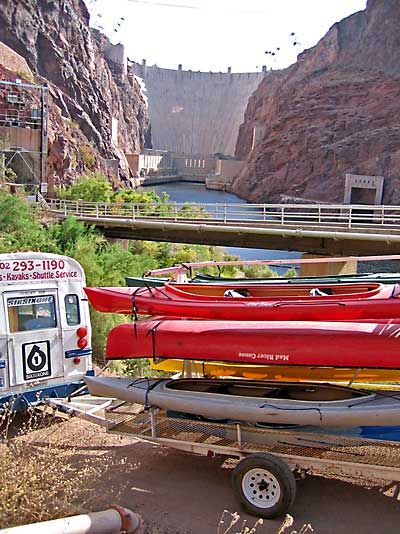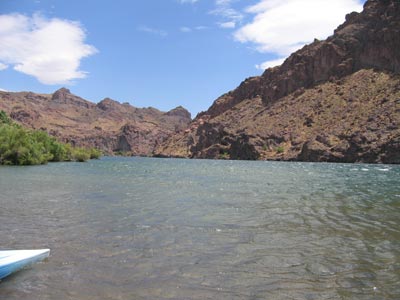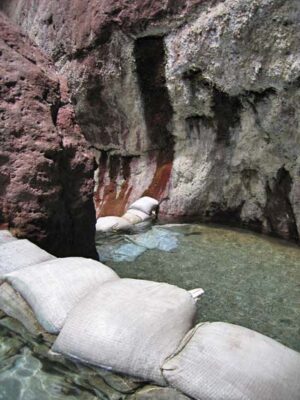

On Memorial Day weekend Ian and I flew to Las Vegas for our 20th river trip, joining twenty-one fellow paddlers, all colleagues and friends from the Design Department of my book publisher, Harcourt Inc. (The trip was organized by Barry, long time designer in Harcourt’s San Diego office.) We all rendezvoused just east of Las Vegas, at Boulder City where we signed for our permits (secured in October of 2004) and climbed into the outfitter’s van and bus for the short trip down to the base of the Hoover Dam. The sight of so much concrete towering above remains awe-inspiring. The outfitter sent the flotilla of kayaks and one canoe (ours) off with the words:
Hope the dam holds today — if it doesn’t, we’ll pick you up in Mexico…
Within a few minutes we turned out of the great dam’s protection and entered the current of the river — and met, head on, a wind so strong that white caps stood up on the water’s surface. Later we learned it was a rare day of 35 mph headwind, with gusts to 50. Our broad, light canoe was blown into the middle of the river repeatedly. Cliffs surrounded all sides. The water temperature was an even 50 degrees.

At the close of maybe the second mile, Ian and I pulled into a tiny rock crevice, protected from the wind. The kayakers were far ahead of us, being boats better suited for the conditions, though they all struggled, too. We held onto cracking branches, huddled back into the rock. My tiny tears evaporated in the dry wind. I didn’t think I could make it ten more miles, I told Ian. We sat there a long time. There were no possible early take-outs. No

beaches to pull up on. The only rest we had planned was a hot springs beach about a third of the way into the trip. We rocked up and down and watched the wind blast the water just beyond our rock, neither of us saying a single word.
Finally, I realized there was nothing else to do but go forward. We devised a plan to stay within six feet of the left cliff bank. We learned how to ease the bow of the canoe out, apply fast, hard cross-draw strokes, and quickly turn around the projecting rocks before the wind could blow us out into the river’s center. Necessity forced us to get very good at this maneuver. Slowly, ever so slowly, we paddled downstream. Many times we were blown back past rocks we had just struggled past. At last we found our group pulled ashore at the hot springs beach. We were all exhausted. Two of our members found it too difficult to continue and were switched to double kayaks with young, strong muscles aboard.




Several of us hiked up to the hot springs, across the crunching gravel, through the rose red rocks, up the shaky iron ladder, following a slowly widening hot stream of water. I soaked in the pooled waters with my colleagues while Ian hiked up to find where the water was only a seeping wetness coming up out of gravel. On the way back down I washed my face in the falling hot water — only to be told by the waiting Boy Scout leader that the water contained a lethal amoeba and should not be applied to the nose, eyes, ears, or mouth. It was almost funny, given how this trip was going…Nonetheless, I quickly washed my face with my water bottle’s clean liquid.
The hikers came back to the beach to find our leader dressed in camouflage gear, ambushing a pack of well-armed fellow designers with high powered water guns!

After multiple ambushes and wild soakings, all turned to pack up. We left the protected beach and turned into the headwind, everyone offering good-natured grumblings and wane messages of support. Two-thirds of the paddle remained before us.

To make a long and agonizing story shorter, Ian and I hugged the cliff for the next nine miles. Instead of dying down with the afternoon, the wind increased. At one point we reached a narrows where great cliffs leaned above us. The water swirled in crazy vortexes, and that added to our troubles. By now, I was paddling on automatic. The only way out was through it. In the narrows I thought I might be going crazy when I found myself repeating: I must get the ring to Mordor, I must get the ring to Mordor…We stopped to rest sometimes, hanging onto brittle branches, never more than a ledge to scramble up. Once Ian found a giant big horn sheep, horns curled around his head, surveying him below.
We did make it to the end, though I just barely made it, collapsing on the sandy beach across the river from the take-out on the wide turn, my muscles quivering in legs, arms. While Ian hiked the roadway to the outfitter’s bus, I cried.
I cried for being so tired, I cried for having made it, I cried for my beloved stepfather, buried just three weeks before. I cried and cried and cried, until I ran out of tears. A young team of paddlers came and took our canoe across the open water of the last 100 yards.
Later, on the bus, I asked people what had helped them get through this. One said, “reducing the size of the goal – making the next turn’s goal closer and closer.” Another said that at first she thought child birth was harder than this, and she’d done that, so she repeated that…but then she found herself saying: “this is harder than childbirth, this is harder than childbirth!” Ian said something that

helped me. Amid a sudden gust that had me furiously paddling so as not to lose ground he called out: Paddle steady when the wind is gusting. Paddle hard when it lets up. That proved to be good advice, and has helped me these months after learning to live with loss and a deep sense of grief. I miss my parents very much. If life is a river, then some days are just going to be all headwind. Here’s what I say: When it gets hard, look for protection. Paddle smart. Don’t give up. Make the smallest accomplishment something to celebrate. Steady. Small. Eventually. The world was gorgeous around us and I have not forgotten a moment of that.